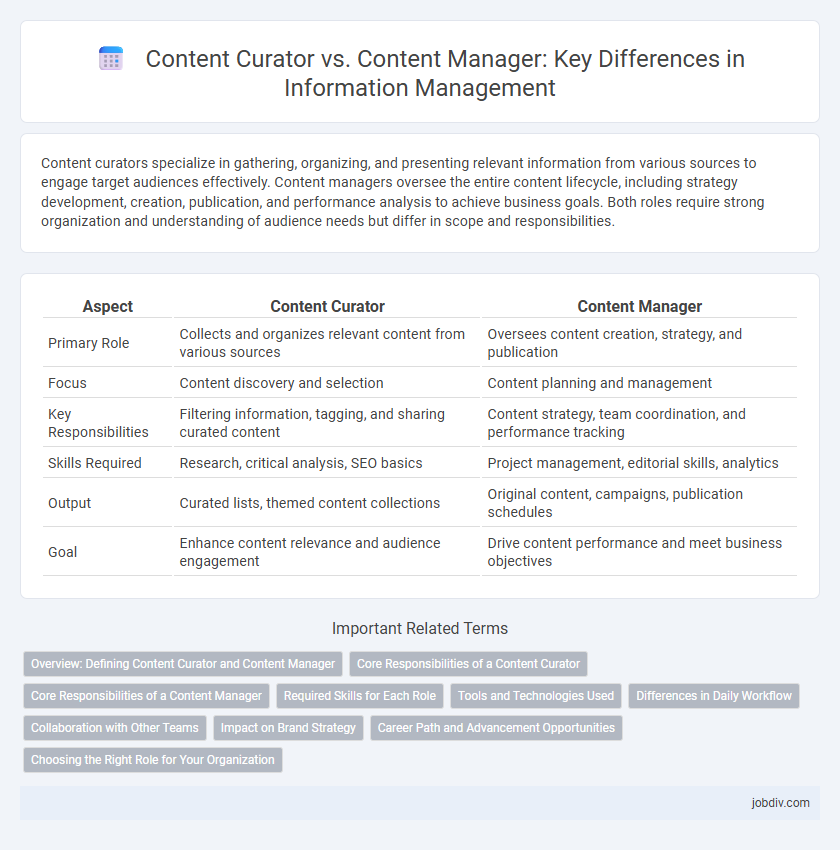Content curators specialize in gathering, organizing, and presenting relevant information from various sources to engage target audiences effectively. Content managers oversee the entire content lifecycle, including strategy development, creation, publication, and performance analysis to achieve business goals. Both roles require strong organization and understanding of audience needs but differ in scope and responsibilities.
Table of Comparison
| Aspect | Content Curator | Content Manager |
|---|---|---|
| Primary Role | Collects and organizes relevant content from various sources | Oversees content creation, strategy, and publication |
| Focus | Content discovery and selection | Content planning and management |
| Key Responsibilities | Filtering information, tagging, and sharing curated content | Content strategy, team coordination, and performance tracking |
| Skills Required | Research, critical analysis, SEO basics | Project management, editorial skills, analytics |
| Output | Curated lists, themed content collections | Original content, campaigns, publication schedules |
| Goal | Enhance content relevance and audience engagement | Drive content performance and meet business objectives |
Overview: Defining Content Curator and Content Manager
Content curators specialize in gathering, organizing, and presenting relevant information from diverse sources to create meaningful content collections tailored to specific audiences. Content managers oversee the planning, creation, publication, and performance analysis of original content, ensuring alignment with brand strategy and business goals. Both roles require strong editorial judgment, but curators focus on curation and aggregation, while managers drive content production and overall strategy execution.
Core Responsibilities of a Content Curator
Content curators specialize in discovering, organizing, and presenting relevant information to target audiences by filtering vast amounts of data. They analyze content quality, ensure relevance, and maintain consistency across platforms while sourcing external and internal materials. Their core responsibilities include researching trending topics, categorizing content for easy access, and enhancing user engagement through strategic content selection.
Core Responsibilities of a Content Manager
A Content Manager oversees the planning, development, and execution of digital content strategies to ensure consistent brand messaging and audience engagement. They coordinate with writers, designers, and marketing teams to produce high-quality content aligned with business goals. Their core responsibilities include content calendar management, performance analysis, and optimizing content for SEO and user experience.
Required Skills for Each Role
Content Curators excel in research, critical analysis, and trend identification, requiring strong skills in content discovery, audience understanding, and digital tools for sourcing information. Content Managers demand expertise in project management, strategic planning, team collaboration, and proficiency with content management systems (CMS) to oversee content creation and distribution effectively. Both roles benefit from excellent communication skills, but Content Managers must also possess leadership abilities and data analytics to optimize content performance.
Tools and Technologies Used
Content curators primarily use tools like Feedly, Pocket, and Scoop.it to aggregate, filter, and organize relevant information from diverse sources efficiently. Content managers rely on comprehensive platforms such as Adobe Experience Manager, WordPress, and HubSpot to plan, create, schedule, and analyze content performance across multiple channels. Both roles utilize analytics tools like Google Analytics and SEMrush for data-driven decisions but differ in their core focus on curation versus strategic content distribution.
Differences in Daily Workflow
Content curators primarily focus on discovering, organizing, and filtering relevant information from various sources to provide value and context for their audience, while content managers oversee the creation, publication, and strategic planning of content across multiple platforms. Curators spend most of their day researching and evaluating external content, whereas managers coordinate with writers, designers, and marketers to ensure cohesive content delivery. The daily workflow difference lies in curation's emphasis on selection and aggregation versus management's focus on production and distribution.
Collaboration with Other Teams
Content curators collaborate closely with marketing and editorial teams to gather and organize relevant information, ensuring consistent and engaging content across channels. Content managers coordinate with design, development, and analytics teams to oversee content creation, publication, and performance optimization. Effective collaboration between content curators and managers enhances workflow efficiency and content quality by aligning strategy and execution.
Impact on Brand Strategy
Content curators enhance brand strategy by selectively gathering and presenting relevant information that aligns with the target audience's interests, fostering engagement and trust. Content managers shape brand strategy by overseeing the creation, scheduling, and consistency of original content, ensuring brand messaging remains cohesive across all channels. Both roles synergize to strengthen brand identity, optimize audience reach, and drive sustained brand loyalty.
Career Path and Advancement Opportunities
Content curators specialize in sourcing, organizing, and sharing relevant information, often focusing on niche topics to build targeted audiences, making this role ideal for those beginning their digital content careers. Content managers oversee the creation, strategy, and performance of content across multiple platforms, requiring leadership skills and strategic planning, which positions them for advanced roles like Digital Marketing Director or Chief Content Officer. Advancement opportunities for content curators typically lead to content strategist positions, while content managers have clearer paths to executive roles in content and marketing departments.
Choosing the Right Role for Your Organization
Content curators gather, organize, and present relevant information to target audiences, ensuring continuous engagement through consistent updates. Content managers oversee the entire content strategy, from creation and publication to performance analysis, aligning content with organizational goals. Selecting the right role depends on whether your organization needs focused content sourcing and curation or a comprehensive approach to content creation, distribution, and strategy management.
Content Curator vs Content Manager Infographic

 jobdiv.com
jobdiv.com